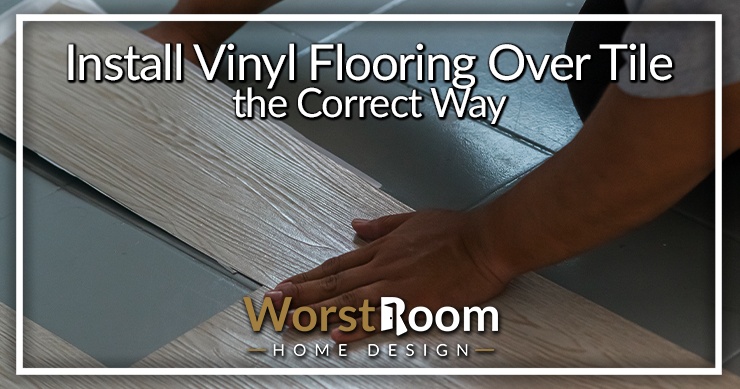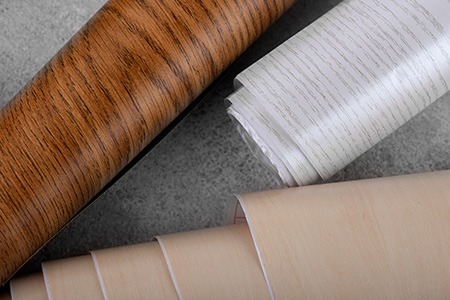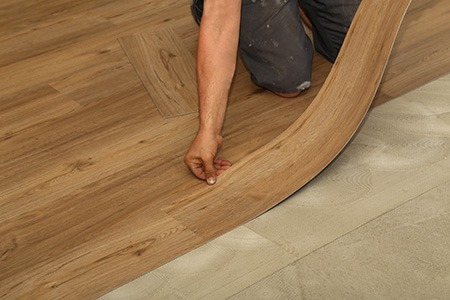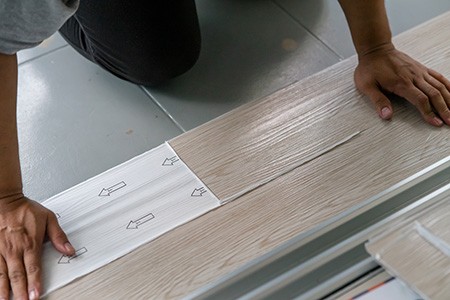Install Vinyl Flooring Over Tile the Correct Way
Author: Omar Alonso | Editor: Omar Alonso
Review & Research: Jen Worst & Chris Miller

Tiles are cold and unforgiving. It's time to make a change to the flooring system in your home. Vinyl floors are warm and come in as many design variations, colors, and patterns as tiles but without the cold chill under your feet. But can you install vinyl flooring over tile or will you have to rip off the old tiles before you lay the new vinyl?
Why Install Vinyl Flooring Systems Over Tiled Floors?
Tiles are challenging to remove. Tiles secure to the floor with cement and grout, giving them a rock-hard finish. It's easier to pull the teeth out of your head with pliers and no anesthetic than it is to remove a tiled flooring.
You'll need to break it up and clear out the debris, requiring time and money to complete the change. Most homeowners don't have the patience to spend their weekends ripping up a tiled floor, so they hire a contractor to do it, increasing the project costs.
So, can you install vinyl flooring over tile? That would make the project much easier. The answer is – Yes; you can, and there's no problem with doing so. The only issue is that the new flooring adds more height to the surface, and you'll have to trim the doorways leading into the rooms to compensate for the new height.
However, if you're installing vinyl flooring in an open space, you won't have this problem. This post gives you an idea of both tasks and the work involved. We'll look at what it takes to remove a tiled floor and install vinyl flooring over tile.
What Are the Types of Vinyl Flooring?

There are three primary types of vinyl flooring options for your new project.
Rolled Vinyl
This vinyl flooring offers you the easiest installation. Lay it down on the floor, roll it out, secure it with staples or glue, and you're good to go.
Vinyl Tiles
Vinyl tiles also make for an easy installation. They come with adhesive on the back of the tile. Peel away the backing and stick them to the floor; it's that simple. They look like standard tiles and even come with faux grout lines.
Vinyl Planks
These flooring boards are the most challenging to install, but it's still way easier than laying a tiled floor. They're laminate boards that secure together in an interlocking system to create the floor. This option doesn't require any adhesive, either.
A Step-by-Step Guide to Removing Tiled Floors

Should I remove ceramic tile before installing vinyl plank flooring? You don’t have to but it may be considered the proper way, assuming you can get or have tile removal tools. Let’s start by looking at what it takes to remove a tiled floor and replace it with vinyl flooring systems.
1) Preparation
Start by preparing the tools for the job. You'll need a sledgehammer to break up the tiles and a hammer and chisel to remove the grout and cement from the floor. We recommend using a respirator mask to prevent breathing in the dust and goggles to stop ceramic chips from blinding you while you cut the floor up.
2) Remove the Grout
The first job is to remove the grout. Use your hammer and chisel or a specialist grout saw for the work. You'll need the respirator for the grout saw, as it produces plenty of dust. Remove the grout, and be careful with your work. It's no biggie if you crack the tiles, but try not to if you can.
3) Clean the Area
After removing the grout, clean up the dust with a vacuum or sweep it up by hand. Removing the grout makes it easier to work on the tiles rather than having dust everywhere.
4) Peel Up the Tiles
You'll need a hammer to break up the tiles and get up under the remainder with a chisel. The tile cement creates a permanent bond, and the tiles stick to the floor securely. Sometimes, you can pop them off if there isn't too much glue underneath.
Start at the edges and work your chisel underneath with your hammer. If you're lucky, they'll pop off; if not, you'll have to break them to remove them.
5) Remove the Mortar
Now that you have the tiles off, it's time to start the worst part of the job – removing the mortar. Mortar is stubborn to remove, and this task can take days to finish. Tap at the mortar with your hammer and chisel and slowly work your way around the room.
Sometimes, the mortar peels up easily; in other cases, it's stubborn, requiring real effort to peel it away. When you reach the thin mortar layer at the bottom, sand it away with a belt sander.
6) Clean the Floor
When you're finished lifting the mortar, it's time to clean up the mess. You'll need a skip to collect the old tiles you don't want to save and all the grout, dust, and mortar.
You'll have to account for these costs in your project. When you're finished with the removal, you can repair the subfloor if needed.
How to Install Vinyl Flooring Over Tile

Now that you've seen the work involved with removing the tiles, you probably want nothing to do with the job. Fortunately, you can install vinyl flooring over tile without any issues. You'll just need to patch the grout lines. These are the only vinyl over tile problems you'll encounter, and they're easy to overcome.
1) Check the Floor for Damaged Tiles
Inspect the tiled flooring for broken tiles. Broken tiles make the floor uneven, and it won't be waterproof. You'll need to remove or repair the broken tiles. Either way, you go; it's a much easier task than digging up the entire tiled surface.
2) Remove the Baseboards
Remove the baseboards from the walls before you start laying the new flooring system. The baseboards fit over the new surface, hiding any inconsistencies in the edges of the new flooring system.
Vinyl floorboards, for example, usually have a half-inch gap at the edge closest to the wall. This gap allows the floor to expand and contract in cold and warm weather.
Baseboards are easy to remove using your hammer and chisel. They should pop off easily with minimal effort. After laying the new flooring system, you'll refit them to the walls, and it won't take much effort.
3) Apply the Patch to the Grout Lines
The patch fills the gaps in the grout lines between the tiles, making a flat, level surface. Fill all the lines and let the patch dry before laying the new vinyl floor.
4) Clean the Floor
Clean up after the patch dries and ensure you remove all the debris. If you install anything left on the surface over dirt, you'll hear the crunching sound of dirt as you walk over the new floor.
5) Lay the Vinyl Flooring Over the Tiles
When you're confident you have a clean floor, it's time to lay the new vinyl flooring. If you use planks or tiles, start in one corner of the room and work your way to the opposite corner. We recommend laying the pattern out before you start to ensure you have the right amount of floorboards or tiles.
6) Cut the Planks
Even if your floor has the right shape and size to avoid cutting the planks, we recommend cutting them anyway to create the look of natural flooring.
The natural alternating pattern gives vinyl; boards to look at hardwood floors, adding more design aesthetic to the room.
We recommend cutting the first vinyl floorboard in half on the second row and every second one afterward. Cut some thirds or quarter boards for a more natural look.
7) Finish the Floor
You can work in rows or a stairstep plan to fit the boards. For boards, we recommend going one row at a time. If you're working with vinyl tiles, we recommend going with the stairstep pattern for the best results with the project.
FAQs Related to Vinyl Flooring Over Tile

We’ve discussed the pros and cons of laying vinyl over tile. Now you’ve probably got several other questions in your mind. Let’s cover those now.
Can You Fit Vinyl Tile Over Ceramic Tile?
Yes. You can fit vinyl floorboards over ceramic tiles. However, you'll need to use a patch to fill in the grout lines if they're deep and wide.
How Long Do Vinyl Planks Last Over Tile?
Vinyl flooring is incredibly durable. With proper installation and maintenance, you can expect your new floor to last up to 20 years, depending on the manufacturing quality.
Do You Need to Install Anything Under Vinyl Tile?
You don't need any felt underlay underneath vinyl flooring. However, a felt underliner is a good idea if you can afford it or if you're using thin vinyl floorboards.
Key Takeaways for Vinyl Over Tile

- Yes. You can install vinyl flooring over tile without any issues.
- You might have to alter the height of the bottom of doors opening into rooms where you install vinyl floorboards or peel-and-stick vinyl tiles of ceramic tiles.
- Installing directly over the tiles is much easier than breaking up the tiled floor.
- Vinyl flooring comes in rolls, tiles, and boards. Boards and tiles are the preferred option, providing the best finish to a flooring system.
- Vinyl boards and tiles are available in endless colors, styles, and designs.
So, Can You Lay Vinyl Flooring Over Tile?
It is entirely possible to install vinyl flooring over tile, though if you’re using thin rolls you’ll want to fill in the grout lines to create a level base for the vinyl to lay over. We offer plenty of guidance to get that done above.



